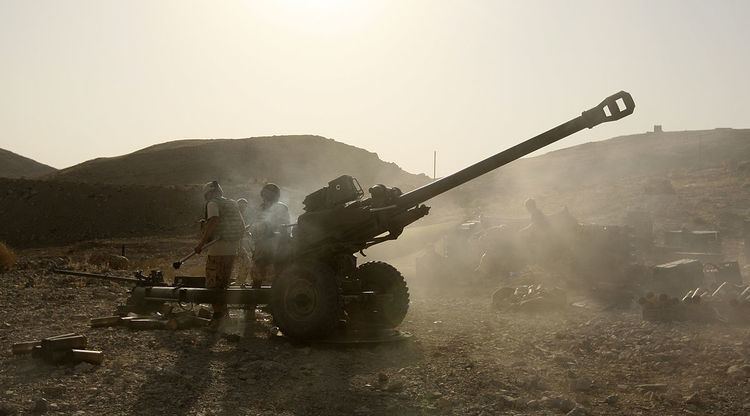Size 4 Batteries | Part of 16 Air Assault Brigade | |
 | ||
Active 27 June 1961 – presentAll of the individual batteries were formed in the period 1800-1805 and have existed continuously since their formation. Role Parachute Light Artillery | ||
7th Parachute Regiment Royal Horse Artillery (7 Para RHA) is a regiment of the Royal Artillery in the British Army. It currently serves in the field artillery role with 16 Air Assault Brigade, and is equipped with the L118 Light Gun.
Contents
The regiment was constituted in 1961 out of existing batteries that have served continuously since the Napoleonic Wars.
History
The regiment was formed on 27 June 1961 with the re-designation of 33rd Parachute Light Regiment Royal Artillery as 7th Parachute Regiment Royal Horse Artillery. The regiment first saw action in the middle-east in Kuwait in 1961 and then in Aden in 1963–65 where it was involved in fierce fighting in the Radfan mountains. The 1970s and 80’s saw the regiment involved in four Northern Ireland tours in the infantry role as well as a period where they briefly lost their airborne status and were arms-plotted to Germany until 1984 when they joined newly formed 5th Airborne Brigade and returned to Aldershot.
In 1994 the regiment deployed to Cyprus as part of the UN mission to patrol the buffer-zone between Cypriot and Turkish forces. This was followed in 1996–97 with two battery deployments to Bosnia as part of the NATO mission and the Kosovo campaign of 1999.
Since the formation of 16 Air Assault Brigade in 1999, 7 Para RHA has been involved in numerous overseas operations. The Sierra Leone campaign in summer 2000 was followed by Op Essential Harvest in Macedonia a year later and then two batteries deployed to the Kabul area of Afghanistan in early 2002.
On the afternoon of 19 March 2003 7 Para RHA fired the first shots of the Iraq war by any coalition ground forces. The next day they crossed the border in support of the US I Marine Expeditionary Force. The regiment was instrumental in securing the strategic Rumalya oilfields and supporting the MEF in their move north to Nasiriyah.
In late 2003 the regiment moved from Aldershot to Colchester to join the rest of 16 Air Assault Brigade. 2006 saw the first of the regiment's three tours of Afghanistan. The first of these saw the regiment play a key role in the break into Helmand province. This tour attracted much public attention and has often been described as the most intense combat fighting since the Korean War of the 1950s. The regiment returned to Helmand two years later and were again involved in heavy fighting – cumulating in the large scale operation to move a turbine from Kandahar along a heavily mined and fiercely defended road to the Kajaki Dam. 7 Para RHA’s final deployment to Afghanistan saw the Regiment’s gun groups and Fire Support Teams deploy to central Helmand Province in order to provide offensive support to 16th Air Assault Brigade.
In May 2013, V Battery was disbanded.
In September 2013, it was part of Exercise Sphinx Resolve.
The Regiment also had an Airborne Air Defence element when part of 5 Airborne Brigade. Better known as P Troop this band of warriors consisted of airborne soldiers who were the most highly trained and elite members of the Regiment and 5 Airborne Brigade.
P Troop moved to Thorney Island for a short period before being disbanded.
Batteries
The batteries are as follows:
